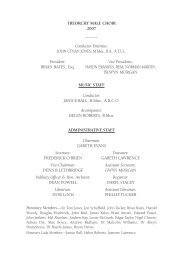EXCELSIOR - Treorchy Male Choir
EXCELSIOR - Treorchy Male Choir
EXCELSIOR - Treorchy Male Choir
You also want an ePaper? Increase the reach of your titles
YUMPU automatically turns print PDFs into web optimized ePapers that Google loves.
<strong>EXCELSIOR</strong> 37<br />
the Controller of the Household making arrangements. But once again these<br />
were scuppered with the death of the Duke of Clarence, the Prince of<br />
Battenburg and that of Sir Hugh Ponsonby.<br />
Major Walter Quinn took up the suggestion again and finally on January 25th<br />
1898 – more than two years since Treorky’s visit – an official letter came from<br />
Quinn inviting them to appear at Windsor. It was closely followed by a<br />
telegram from Sir Walter Parratt, the Queen’s Organist, directing them to<br />
appear in evening dress – and not “Sunday Best” as had been Treorky’s way.<br />
While Treorky had taken Dr Joseph Parry as their guest of honour to Windsor,<br />
Tom Stephens invited his good friend Eos Dar, the famous Pennillion Singer<br />
and multiple-winner at the National Eisteddfod of Wales. Ironically enough,<br />
six members of the Glee Society had previously sang with Treorky and<br />
appeared with them before the Queen in 1895.<br />
On February 22nd 1898 the <strong>Choir</strong> left Ystrad train station to a huge sendoff.<br />
Along the hillsides of Penrhys and Gelli people waved at the royal singers<br />
while crowds gathered at Pontypridd and Cardiff to greet the choristers<br />
through the windows of their saloons of the Great Western Railway carriages.<br />
They reached Windsor at 6.10pm, settling into their accommodation at the<br />
White Hart Hotel and enjoying tea in the dining room where Mabon struck<br />
up “Crugybar” and the <strong>Choir</strong> sang for a few minutes before Tom Stephens<br />
ordered silence for fear they would lose their voices. He did, however allow<br />
them a rehearsal of “God Save the Queen” before they departed for their<br />
rooms to don their evening dress and white gloves, also bearing breast badges<br />
to say they’d won the National Eisteddfod in Pontypridd.<br />
At 8.45pm they formed a procession up Castle Hill and entered through the<br />
Grand Entrance to be met by Mr Miles of the Lord Chamberlain’s<br />
Department in the cloakroom. Then they were led up the grand staircase to<br />
St George’s Hall where an orchestra had been erected and six tiers of seats for<br />
the Welshmen. A group of 36 gilded chairs in six rows were placed for the<br />
audience with a low armed black oak chair, richly upholstered, stood in the<br />
centre alongside a small table holding a pair of opera glasses, a magnifying<br />
lens and a copy of the concert programme bound in red borocco.<br />
Mr D. Jones sat at the grand piano and Percie Smith was sat at the American<br />
organ. Punctually at 10pm the bells chimed and the doors opened into the<br />
hall. The Ladies and Gentlemen of the Household, with Lord Edward<br />
Clinton, Controller of the Household appearing to signal the Queen’s<br />
approach. They all rose to the majestic strains of the National Anthem. The<br />
Queen, bent over, walked slowly. Her right hand was resting on a stick, her<br />
left holding her Indian attendant. Dressed in black with a flowing white head



